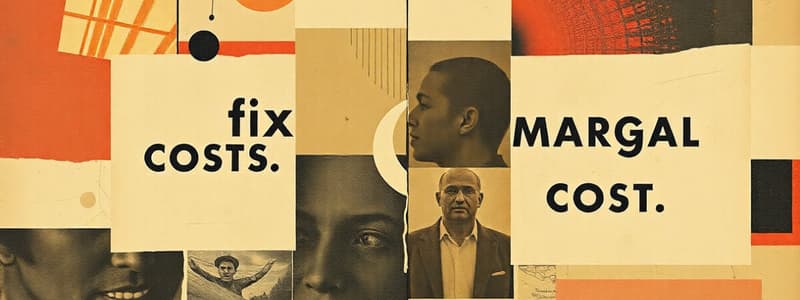Podcast
Questions and Answers
In economics, what distinguishes the short run from the long run for a firm?
In economics, what distinguishes the short run from the long run for a firm?
- The presence of at least one fixed input. (correct)
- The ability to alter all input quantities.
- The variability of consumer demand.
- The length of time, typically less than one year.
Which of the following costs would be considered a fixed cost for a small bakery?
Which of the following costs would be considered a fixed cost for a small bakery?
- The wages paid to hourly employees.
- The monthly rent for the bakery space. (correct)
- The cost of electricity used for baking.
- The cost of flour and sugar.
A local toy manufacturer increases its production. What cost is most likely to increase?
A local toy manufacturer increases its production. What cost is most likely to increase?
- Total Fixed Cost (TFC).
- Total Variable Cost (TVC). (correct)
- Average Fixed Cost (AFC).
- Marginal Cost (MC).
What does the 'Law of Diminishing Returns' primarily refer to?
What does the 'Law of Diminishing Returns' primarily refer to?
How is Marginal Cost (MC) calculated?
How is Marginal Cost (MC) calculated?
If a firm's marginal cost is currently below its average cost, what must be true?
If a firm's marginal cost is currently below its average cost, what must be true?
A company is experiencing 'increasing returns to scale'. What does this mean?
A company is experiencing 'increasing returns to scale'. What does this mean?
Which of the following is an example of an economy of scale?
Which of the following is an example of an economy of scale?
What is a primary cause of diseconomies of scale?
What is a primary cause of diseconomies of scale?
What is the Minimum Efficient Scale (MES)?
What is the Minimum Efficient Scale (MES)?
How is Total Revenue (TR) calculated?
How is Total Revenue (TR) calculated?
If a firm is a price taker, what is the shape of its demand curve?
If a firm is a price taker, what is the shape of its demand curve?
Which formula correctly calculates Average Revenue (AR)?
Which formula correctly calculates Average Revenue (AR)?
What does Marginal Revenue (MR) represent?
What does Marginal Revenue (MR) represent?
What is the relationship between Price Elasticity of Demand and a firm's sales revenue?
What is the relationship between Price Elasticity of Demand and a firm's sales revenue?
When demand for a product is inelastic, what happens to Total Revenue (TR) if the price increases?
When demand for a product is inelastic, what happens to Total Revenue (TR) if the price increases?
What does a negative income elasticity of demand indicate?
What does a negative income elasticity of demand indicate?
If the cross-price elasticity of demand between two goods is positive, the goods are:
If the cross-price elasticity of demand between two goods is positive, the goods are:
What does price elasticity of supply measure?
What does price elasticity of supply measure?
Which factor would likely lead to a more price-elastic supply?
Which factor would likely lead to a more price-elastic supply?
For a perfectly competitive firm, what is the relationship between price (P), marginal revenue (MR), and average revenue (AR)?
For a perfectly competitive firm, what is the relationship between price (P), marginal revenue (MR), and average revenue (AR)?
Suppose a firm's Total Fixed Costs (TFC) are $100, and its Total Variable Costs (TVC) are $300 when it produces 10 units. What is the firm's Total Cost (TC)?
Suppose a firm's Total Fixed Costs (TFC) are $100, and its Total Variable Costs (TVC) are $300 when it produces 10 units. What is the firm's Total Cost (TC)?
Using the information from the previous question (TFC=$100, TVC=$300, Q=10), what is the firm's Average Fixed Cost (AFC)?
Using the information from the previous question (TFC=$100, TVC=$300, Q=10), what is the firm's Average Fixed Cost (AFC)?
Building on the previous questions (TFC=$100, TVC=$300, Q=10), what is the firm's Average Variable Cost (AVC)?
Building on the previous questions (TFC=$100, TVC=$300, Q=10), what is the firm's Average Variable Cost (AVC)?
A company finds that as it increases its scale of production, its Long Run Average Costs (LRAC) decrease. What is this an example of?
A company finds that as it increases its scale of production, its Long Run Average Costs (LRAC) decrease. What is this an example of?
In the long run, a firm can experience constant returns to scale. What does this imply for the firm's cost structure?
In the long run, a firm can experience constant returns to scale. What does this imply for the firm's cost structure?
A local pizza restaurant calculates that its monthly rent is $2,000, salaries are $6,000, and ingredient costs are $4,000. If it sells 2,000 pizzas per month, what is the average total cost per pizza?
A local pizza restaurant calculates that its monthly rent is $2,000, salaries are $6,000, and ingredient costs are $4,000. If it sells 2,000 pizzas per month, what is the average total cost per pizza?
Suppose a company is producing at a point where its marginal cost is greater than its average cost. What does this imply about the average cost?
Suppose a company is producing at a point where its marginal cost is greater than its average cost. What does this imply about the average cost?
What economic term describes the benefit a company receives from specializing its labor force?
What economic term describes the benefit a company receives from specializing its labor force?
When a firm experiences diseconomies of scale, what is most likely happening to its managerial effectiveness?
When a firm experiences diseconomies of scale, what is most likely happening to its managerial effectiveness?
What might a company do with an inelastic product to increase revenue
What might a company do with an inelastic product to increase revenue
What is the formula for the income elasticity of demand?
What is the formula for the income elasticity of demand?
What does a negative result of a cross price elasticity of demand calculation tell us?
What does a negative result of a cross price elasticity of demand calculation tell us?
What calculation tells us the price elasticity of supply?
What calculation tells us the price elasticity of supply?
What is the likely result of imposing a large cost to convert to product x from another product?
What is the likely result of imposing a large cost to convert to product x from another product?
Flashcards
Fixed Costs
Fixed Costs
Costs that do not vary with the quantity of output produced.
Variable Costs
Variable Costs
Costs that vary with the quantity of output produced.
Short Run
Short Run
The period where at least one input is fixed.
Long Run
Long Run
Signup and view all the flashcards
Law of Diminishing Returns
Law of Diminishing Returns
Signup and view all the flashcards
Marginal Cost
Marginal Cost
Signup and view all the flashcards
Average Fixed Cost (AFC)
Average Fixed Cost (AFC)
Signup and view all the flashcards
Average Variable Cost (AVC)
Average Variable Cost (AVC)
Signup and view all the flashcards
Average Cost (AC)
Average Cost (AC)
Signup and view all the flashcards
Marginal & Average Cost Relationship
Marginal & Average Cost Relationship
Signup and view all the flashcards
Economies of Scale
Economies of Scale
Signup and view all the flashcards
Diseconomies of Scale
Diseconomies of Scale
Signup and view all the flashcards
Long-Run Average Cost (LRAC)
Long-Run Average Cost (LRAC)
Signup and view all the flashcards
Minimum Efficient Scale
Minimum Efficient Scale
Signup and view all the flashcards
Total Revenue (TR)
Total Revenue (TR)
Signup and view all the flashcards
Average Revenue (AR)
Average Revenue (AR)
Signup and view all the flashcards
Marginal Revenue (MR)
Marginal Revenue (MR)
Signup and view all the flashcards
Income Elasticity of Demand (YED)
Income Elasticity of Demand (YED)
Signup and view all the flashcards
Normal Goods
Normal Goods
Signup and view all the flashcards
Inferior Goods
Inferior Goods
Signup and view all the flashcards
Cross-Price Elasticity of Demand
Cross-Price Elasticity of Demand
Signup and view all the flashcards
Substitute Goods
Substitute Goods
Signup and view all the flashcards
Complementary Goods
Complementary Goods
Signup and view all the flashcards
Price Elasticity of Supply
Price Elasticity of Supply
Signup and view all the flashcards
Study Notes
- Managing costs is addressed through the concepts of fixed and variable costs.
- Business cost and revenue will be discussed.
Learning Objectives/Types of Costs
- Short run and long run costs are to be covered.
- Fixed costs are part of the learning objectives
- Variable costs are to be covered
- Understanding average, marginal, and total costs is an objective.
- The Law of Diminishing Returns is a key concept
- Economies and diseconomies of scale are important
- Total revenue will be discussed
Production Costs in the Short Run
- Short-run and long-run production involves fixed and variable inputs
- In the short run, some inputs are fixed
- In the long run, all inputs are variable
- Short-run production is subject to the law of diminishing returns
Diminishing Returns
- With one or more inputs fixed, extra output from additional units of a variable input diminish beyond a certain point
Costs and Inputs
- Costs relate to the productivity of factors like labor, with more productive workers impacting costs
- Costs are affected by the price of factors; rising labor costs impact building companies.
- Total costs include total fixed costs (TFC), an example is a classroom
- Total variable costs are denoted as (TVC)
- TVC relates to the law of diminishing returns
- Total cost equation: TC = TFC + TVC, this is individual cost
Question
- The rent on the workshop is a fixed cost for a handmade furniture manufacturer.
Marginal Cost
- Marginal cost defines how much it costs to produce one extra unit of output
- Marginal cost equation: MC = ΔTC / ΔQ
- Marginal cost relates to the law of diminishing returns
Average Cost
- Average fixed cost equation: AFC = TFC / Q
- Average variable cost equation: AVC = TVC / Q
- Average cost equation: AC = TC / Q = AFC + AVC
Average and Marginal Costs
- The shape of the average cost (AC) curve depends on the shape of the marginal cost (MC) curve
Key Rules
- If marginal cost equals average cost, the average cost will not change
- If marginal cost is above average cost, the average cost will rise
- If marginal cost is below average cost, the average cost will fall
Question
- If marginal cost is below average cost, then average cost is falling.
Production Costs in the Long Run
- All inputs are variable in the long run
Scale of Production
- Constant returns to scale mean scaling up does not provide a cost advantage
- Increasing returns to scale mean scaling up inputs increases productivity
Why Firms Scale Up
- Specialization and division of labor are reasons for scaling up
- Indivisibilities are factors
- Greater efficiency of large machines enable scale
- Multi-stage production enables scale
- Organizational and administrative economies are enabled by scaling up
- Financial economies are a factor for scaling up
- Economies of scope, such as in a villa, are a reason to scale
Question
- Economies of scale means large-scale production leads to lower costs per unit of production
Diseconomies of Scale
- Managerial diseconomies can cause disconnection with workers
- The Effects of workers and industrial relations
- Risks of interdependencies increase with scale
- External economies of scale affect the whole industry
- External diseconomies of scale also affect the whole industry
- Economies of scale occur up to a certain output
- Diseconomies of scale occur when firms become very large
Long-Run Average Cost
- The shape of the LRAC (long-run average cost) curve depends on economies or diseconomies of scale
- Assumptions behind the LRAC curve include: input prices are given, state of technology and input quality are given and firms operate efficiently.
Typical Long-Run Average Cost Curve
- Curve illustrates economies of scale, constant costs, and diseconomies of scale.
Question
- Minimum efficient scale is the point where LRAC levels off
Defining Revenue
- Total, average, and marginal revenue must be defined
Equations
- Total Revenue (TR) = Price (P) × Quantity (Q)
- Average Revenue (AR) = TR / Q
- Marginal Revenue (MR) = ΔTR / ΔQ
- Revenue curves for price takers are horizontal demand curves
Revenue
- Average revenue (AR) is relevant
- Marginal revenue (MR) is relevant
Learning Outcome Key Terms
- Total costs are the sum of fixed and variable costs
- The Law of Diminishing Returns applies in the short run
- Costs are different in the short run and long run.
- Average Cost (AC), Marginal Cost (MC) are important calculation
- Economies of scale are relevant in the long run
- Diseconomies of scale should be calculated
- Total Revenue (TR), Average Revenue (AR), and Marginal Revenue (MR) should be calculated.
Price Elasticity of Demand and Business
- Price elasticity of demand and a firm's sales revenue where revenue defined as TR = P x Q
Effects of Price Change on Sales Revenue
- With elastic demand, TR changes in the same direction as quantity
- With inelastic demand, TR changes in the opposite direction as quantity
Elastic Demand
- Elastic demand means expenditure falls as price rises
Inelastic Demand
- Inelastic demand means expenditure rises as price rises
Income Elasticity of Demand
- Income elasticity of demand is (YεD)
- Measurement: %ΔQ / %ΔY
Measurement: %∆Q/%∆Y
- Normal goods have positive elasticity.
- Inferior goods have negative elasticity; a rise in income leads to a fall in demand
Determinants
- The Degree of 'necessity' of the good
- Applications to business involves importance of perceptions of the product
- Repositioning a product
Cross-Price Elasticity of Demand
- Measurement: %ΔQDa / %ΔPb
Measurements
- Substitute goods have positive elasticity
- Complementary goods have negative elasticity
- Closeness of complements or substitutes
- The time period is relevant
- Effects of changes in competitors’ pricing strategy impacts business
- Strategies to make a product less cross-elastic will improve business
Price Elasticity of Supply
- Measured as (%∆Qs/ %∆Ρ)
- Determinants depend on how much costs rise as output increases
- Time period depends on the immediate term, short run, and long run
Different Price Elasticity of Supply
- Inelastic supply is shown as S1
- Elastic Supply is shown as S2
Question
- Good X is likely to have a more price-elastic supply than good Y if the cost of producing extra units increases more rapidly in the case of Y than in the case of X.
Next Lecture
- Perfect competition is the next lecture topic.
Studying That Suits You
Use AI to generate personalized quizzes and flashcards to suit your learning preferences.




